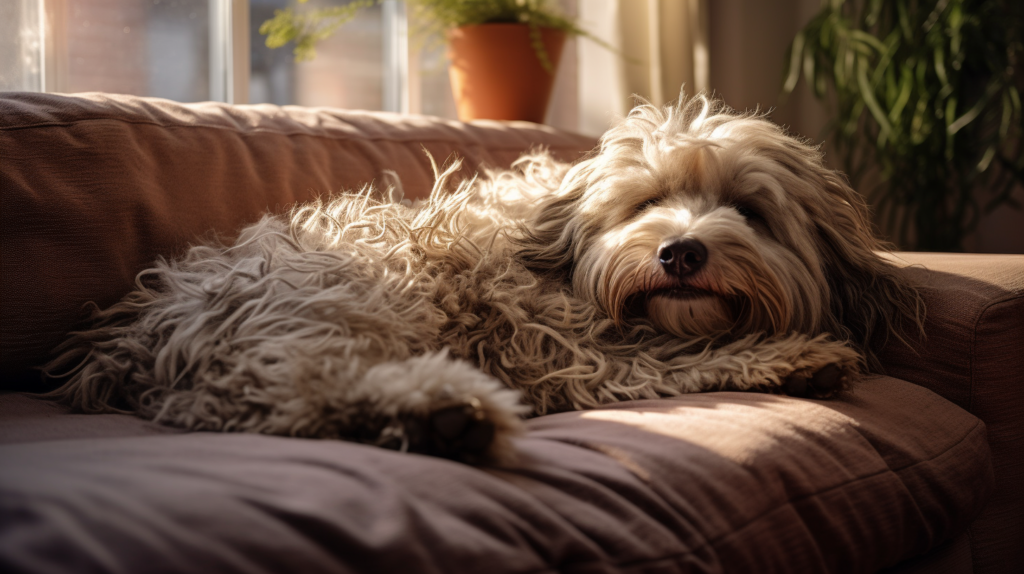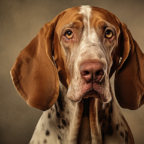Click and GO TO THE BEST DOG NAME GENERATOR HERE

The Bergamasco Sheepdog is a distinct breed known for its unique matted coat and low-maintenance requirements, making it an excellent choice for apartment living. When selecting a dog for an apartment, it is crucial to consider factors beyond size alone.
While some larger breeds can adapt well to lower activity levels, certain small breeds with higher energy levels can still thrive in apartments. It is important to prioritize qualities such as being quiet, low-energy, calm indoors, and well-mannered in shared spaces. Dogs that display excessive barking or disruptive behavior may not be suitable for apartment living.
The Bergamasco Sheepdog possesses a low sensitivity level and tolerance for being alone, making it well-suited for apartment dwellers. Furthermore, with the appropriate care, it can tolerate cold weather.
Overall, the Bergamasco Sheepdog is an affectionate and low-maintenance companion, making it an ideal choice for those living in apartments.
Key Takeaways
- Bergamasco Sheepdogs have a unique matted, mop-like coat and a distinctive appearance with long, thick hair.
- They are low-maintenance and require minimal grooming.
- They have a friendly and social disposition, which makes them suitable for apartment living.
- When choosing a dog for an apartment, size alone should not be the sole determinant, and factors such as behavior towards neighbors and in shared spaces should be considered.
Distinctive Appearance
The Bergamasco Sheepdog is known for its distinctive appearance characterized by a long, thick, and matted coat, making it easily recognizable among other breeds.
This unique coat is made up of three types of hair: the oily undercoat, the fine and dense middle coat, and the outer coat, which forms mats or flocks. These mats serve as a protective layer, shielding the dog from harsh weather conditions and providing insulation.
The coat is also hypoallergenic, making it suitable for individuals with allergies.
In addition to its coat, the Bergamasco Sheepdog has a muscular and well-proportioned body. Its head is large and square, with a strong and slightly arched neck.
With its distinctive appearance, the Bergamasco Sheepdog stands out and captures attention wherever it goes.
Adaptability to Apartments
Adaptability to apartment living can vary depending on a dog’s energy levels and behavior in shared spaces. While it is commonly believed that only small dogs thrive in apartments, this is not entirely true. Some larger breeds can adapt well to apartment living as long as their activity levels are lower.
On the other hand, certain small breeds with high energy levels can still thrive in apartments if they are provided with sufficient exercise and mental stimulation. When choosing a dog for an apartment, it is important to consider their behavior towards neighbors and in shared spaces.
Quiet, low-energy, and well-behaved dogs are desirable for apartment living to avoid disturbing neighbors. Size alone should not be the sole determinant for apartment suitability, as it is crucial to prioritize qualities such as being calm indoors and well-mannered.
Factors to Consider
Consideration must be given to various factors when selecting a dog for apartment living. Here are five key factors to consider:
- Size: While size alone should not be the sole determinant, it is important to choose a dog that can comfortably live in a smaller space. Some large breeds can adapt well to apartments with lower activity levels, while certain small breeds with higher energy levels can still thrive in apartments.
- Behavior: It is crucial to consider how a dog will behave towards neighbors and in shared spaces. Dogs that excessively bark or have disruptive behavior can disturb neighbors. Therefore, prioritize qualities such as being quiet, low-energy, calm indoors, and well-mannered.
- Energy Level: Dogs with high energy levels may not be ideal for smaller apartments. It is advisable to choose a breed that matches the activity level and exercise requirements that can be accommodated within the apartment setting.
- Training: Consider the dog’s trainability and the owner’s experience. Some breeds are easier to train and more easygoing, while highly sensitive or independent dogs may be harder for first-time owners. Prioritize dogs that are resilient and can bounce back from mistakes or inconsistencies.
- Compatibility: Ensure that the dog’s temperament and needs align with the owner’s lifestyle and household. Dogs that are tolerant, resilient, and thick-skinned are well-suited for families with young kids or busy lives. Consider the dog’s sensitivity level and whether they can handle noisy, chaotic households and assertive owners.
Breeds Not Suited for Apartments
Breeds that require more space and have higher energy levels may not be ideal for smaller living environments. These dogs may struggle to adapt to the limited space and may become restless or frustrated. Additionally, their high energy levels may make it challenging for them to get the exercise they need in a smaller apartment setting. It is important to consider the needs and characteristics of specific breeds before choosing a dog for apartment living.
Here is a table comparing some breeds that may not be well-suited for apartments:
| Breed | Energy Level | Space Requirements | Suitability for Apartments |
|---|---|---|---|
| Border Collie | High | Large yard | Not recommended |
| Siberian Husky | High | Large yard | Not recommended |
| Dalmatian | High | Large yard | Not recommended |
| Jack Russell Terrier | High | Moderate space | May not be suitable |
It is important to note that individual dogs within a breed can vary in their energy levels and adaptability. Proper exercise and mental stimulation can help alleviate some challenges associated with higher energy breeds in apartment living. However, it is generally advisable to prioritize breeds that are naturally more low-energy and suited for smaller living spaces.
Suitable for Novice Owners
Novice dog owners should prioritize breeds that are known for being easy to train and more easygoing, as these dogs are more resilient and forgiving of mistakes or inconsistencies. When choosing a dog for the first time, consider breeds that have a reputation for being beginner-friendly. Some breeds that are suitable for novice owners include:
- Labrador Retrievers: These dogs are known for their friendly and outgoing nature. They are highly trainable and eager to please, making them a great choice for beginners.
- Cavalier King Charles Spaniels: These small and affectionate dogs are known for their gentle temperament. They are easy to train and adapt well to different living situations.
- Bichon Frises: These small, fluffy dogs are known for their friendly and sociable nature. They are intelligent and easy to train, making them a good choice for novice owners.
By choosing a dog breed that is known for being easygoing and trainable, novice owners can have a more positive experience and build a strong bond with their new furry friend.
Sensitivity Level
Sensitivity levels in dogs can vary, with some dogs being more tolerant and resilient in noisy and chaotic households. These dogs are considered low-sensitivity and are well-suited for families with young children or busy lifestyles. They can handle assertive owners and thrive in environments with high activity levels.
Low-sensitivity dogs are known for their ability to bounce back from mistakes or inconsistencies in training. They are generally thick-skinned and can handle rough play or accidental mishaps. Their easygoing nature makes them suitable for novice owners who may not have much experience in dog ownership.
It is important to consider the sensitivity level of a dog when choosing a pet, as it can greatly affect their adaptability and overall well-being in a variety of household situations.
Tolerance of Being Alone
One important factor to consider when choosing a dog for apartment living is their tolerance of being alone. Not all dogs are comfortable being left alone for extended periods of time, and some may become anxious or exhibit destructive behavior when separated from their owners. To help prospective apartment dwellers make an informed decision, here are four key points to consider:
- Breeds that tolerate being alone: Some breeds, such as the Basset Hound or the Shar Pei, are known for their independence and ability to handle solitude. These dogs are better suited for owners who work outside the home or have a busy lifestyle.
- Dogs that need constant companionship: On the other hand, breeds like the Bichon Frise or the Cavalier King Charles Spaniel thrive on human interaction and may struggle with being left alone. These dogs require a family member to be present most of the time.
- Training and socialization: Regardless of the breed, it’s important to train and socialize your dog from a young age to help them develop the skills needed to be comfortable when alone. This includes gradually increasing the duration of time spent apart and providing mental stimulation in the form of toys or puzzles.
- Consideration for alternative options: If you know you will be away from home for long periods of time, it may be worth considering alternatives such as doggy daycare or hiring a dog walker to ensure your furry companion receives the attention and stimulation they need.
By considering a dog’s tolerance of being alone, apartment dwellers can choose a breed that will be content and well-adjusted in their living environment.
Tolerance of Weather
When considering the suitability of a dog for apartment living, it is important to assess their tolerance of different weather conditions.
Some dogs, such as those with short coats or little body fat, may be more vulnerable to the cold. Breeds like the Greyhound, for example, may need to live indoors in cool climates. It is advisable to provide a jacket or sweater for dogs with low cold tolerance and to protect them from the cold during walks or outdoor activities.
On the other hand, dogs with thick, double coats may be more prone to overheating in hot weather. Breeds with short noses, like Bulldogs or Pugs, have difficulty cooling themselves off and should stay indoors on warm or humid days. It is crucial to be cautious when exercising dogs in hot weather, and some breeds may require extra precautions.
Frequently Asked Questions
What is the history and origin of the Bergamasco Sheepdog breed?
The Bergamasco Sheepdog is an ancient breed that originated in the Italian Alps, specifically in the region of Bergamo. The exact history of the breed is unclear, but it is believed to have been developed by the shepherds of the region for their herding and guarding abilities.
The Bergamasco’s distinctive coat, which forms mats or ‘flocks,’ helps protect them from the harsh mountain climate. They are an intelligent and adaptable breed, well-suited for various tasks and living environments.
How often does the Bergamasco Sheepdog’s unique coat need to be groomed?
The grooming needs of a Bergamasco Sheepdog’s unique coat are minimal. Due to its distinctive matted, mop-like hair, the coat requires minimal grooming and maintenance.
The Bergamasco’s coat naturally forms dense mats, which protect it from the elements. Regular brushing is not necessary, as the mats should not be separated.
However, occasional bathing and checking for any debris or tangles is recommended. Overall, the Bergamasco Sheepdog’s coat is low-maintenance, making it suitable for apartment living.
Are there any specific training or socialization needs for the Bergamasco Sheepdog?
Training and socialization are important for all dogs, including the Bergamasco Sheepdog.
Early and consistent training is recommended to ensure proper behavior and obedience. Positive reinforcement methods work well with this breed, as they respond well to praise and rewards.
Socialization is also crucial to expose the Bergamasco Sheepdog to various people, animals, and environments. This helps them develop into well-rounded and confident dogs.
Regular training sessions and providing opportunities for socialization will help the Bergamasco Sheepdog thrive in different situations.
Can the Bergamasco Sheepdog live comfortably in a small apartment without access to a yard?
Yes, the Bergamasco Sheepdog can live comfortably in a small apartment without access to a yard. Despite their large size, Bergamascos are adaptable and can thrive in apartment living as long as their energy levels are considered and they receive regular exercise.
They have a low-energy, calm demeanor indoors and are well-behaved, making them suitable for apartment environments.
Their minimal grooming needs and friendly, social disposition make them an ideal choice for apartment dwellers.
Are there any health concerns or potential issues that owners should be aware of for the Bergamasco Sheepdog breed?
Owners of the Bergamasco Sheepdog should be aware of potential health concerns and issues that may arise. This breed is generally healthy, but like all dogs, they can be prone to certain conditions.
Some health concerns that owners should be mindful of include hip dysplasia, progressive retinal atrophy (PRA), and allergies.
Regular veterinary check-ups, a balanced diet, and proper exercise can help maintain the overall health and well-being of the Bergamasco Sheepdog.
We hope you enjoyed the article and see you in the next
Welcome to our ever-growing collection of Italian Dog Breeds! As we continually dive deeper into the marvelous world of these dogs, you can expect this list to expand further.
We’ve curated this selection for you to explore and enjoy. Remember, your experience matters to us! So, don’t hesitate to tell us which Italian dog breed tugs at your heartstrings the most.
What’s more, we’d absolutely love to see images of these captivating breeds from your personal collection. If you’d like to share, we encourage you to send them in! Immerse yourself in this delightful canine journey, and remember to share your favorites with us. Let’s celebrate the beauty of Italian Dog Breeds together!
Our wealth of information about Italian Dog Names comes from a diverse blend of resources, complemented by our own extensive knowledge. We’ve strived to create the most comprehensive online hub for everything related to Italian Dog Names, and we couldn’t have done it without some highly respected and incredibly useful references.
Whether you’re searching for the perfect Italian name for your canine companion, looking for Italian words and phrases for training, or curious about the various Italian dog breeds, rest assured that our content is thoroughly researched.
Our work is a meticulously woven tapestry of information that we’ve compiled from these trusted sources. As we continue to grow our website, we commit to maintaining this high standard of quality and accuracy in our content. So, sit back, explore, and enjoy your journey through the world of Italian Dog Names with us.
- Bergamasco Shepherd
- Bracco Italiano
- Cane Corso
- Cirneco dell’Etna
- Italian Dog Breeds article
- Lagotto Romagnolo
- Levriero Sardo
- Pyrenean Sheepdog
- Segugio Maremmano
- Volpino Italiano
- Spinone Italiano
- Cane di Oropa
- Italian Greyhound
- Rafeiro do Alentejo
- Segugio Italiano
Welcome to the heart of everything that revolves around Italian Dog Names! But we’re not merely stopping at offering you an array of charming names for your furry companion. Oh no, our dedication goes far beyond that.
With an earnest desire to enrich your bonding experience with your dog, we dive headfirst into the realm of Italian dog commands. An absolutely indispensable section, it aids in training your canine pal impeccably, regardless of whether you plan to use these Italian phrases or commands in your routine or not.
And then, we have a whole new section devoted entirely to the myriad Italian Dog Breeds. Here, we walk you through the wide-ranging breeds associated with Italy. Some of these, you might be surprised to learn, are often not perceived as Italian breeds. Yet, they share a rich and complex bond with Italy, either historically or otherwise.
Naturally, our list would be incomplete without spotlighting the authentic Italian dog breeds that are purebreds, with their lineage tracing straight back to Italy. These breeds are Italy’s very own, born and bred on its enchanting soil.
So, whether you’re a dog lover, an enthusiast for all things Italian, or simply curious, we invite you to immerse yourself in our website. Most importantly, revel in the unique charm of your Italian Dog Breed. We promise you an engaging journey, filled with delightful discoveries. Welcome, and enjoy the exploration!



